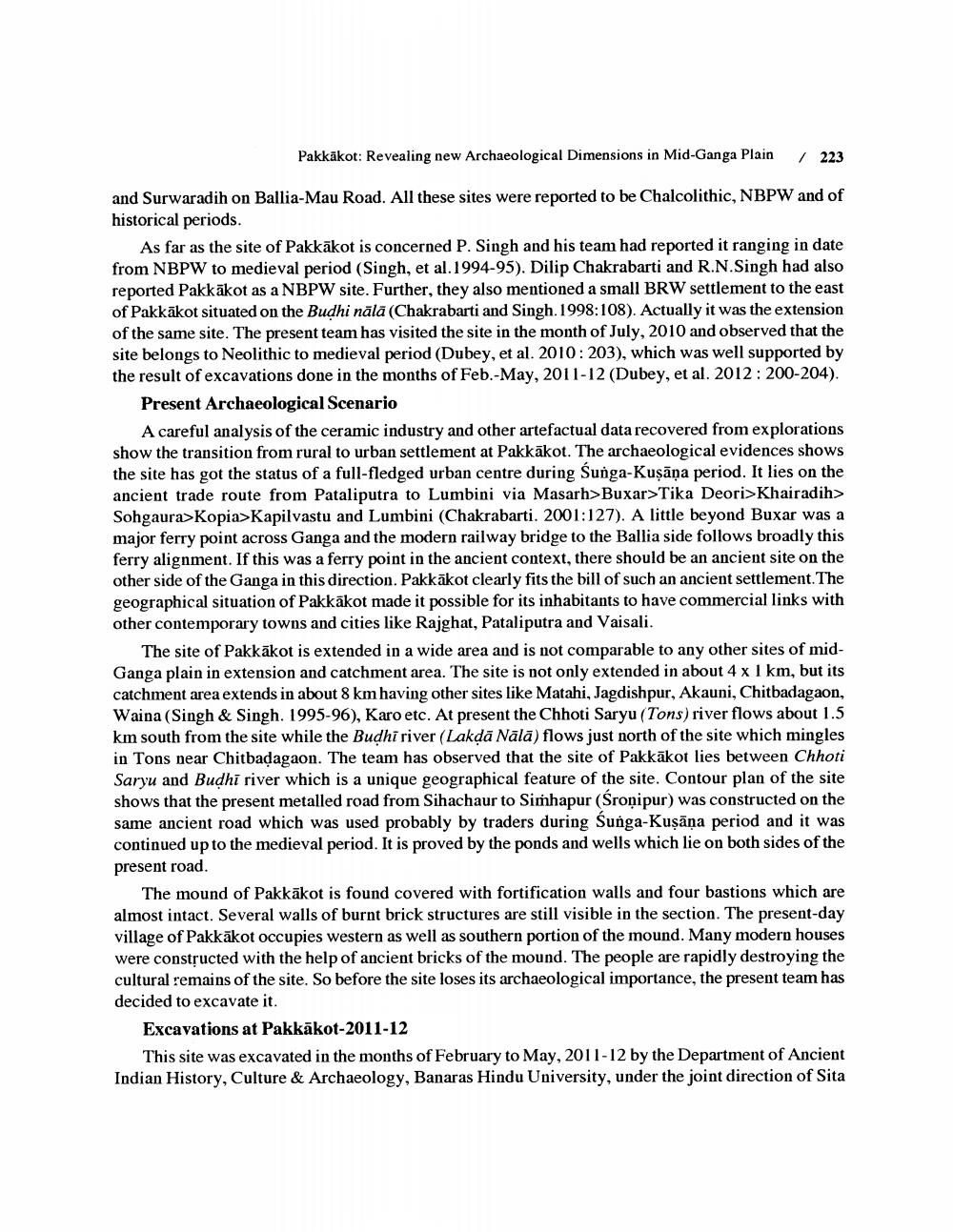________________
Pakkakot: Revealing new Archaeological Dimensions in Mid-Ganga Plain / 223 and Surwaradih on Ballia-Mau Road. All these sites were reported to be Chalcolithic, NBPW and of historical periods.
As far as the site of Pakkakot is concerned P. Singh and his team had reported it ranging in date from NBPW to medieval period (Singh, et al. 1994-95). Dilip Chakrabarti and R.N.Singh had also reported Pakkakot as a NBPW site. Further, they also mentioned a small BRW settlement to the east of Pakkakot situated on the Budhi nälä (Chakrabarti and Singh. 1998:108). Actually it was the extension of the same site. The present team has visited the site in the month of July, 2010 and observed that the site belongs to Neolithic to medieval period (Dubey, et al. 2010: 203), which was well supported by the result of excavations done in the months of Feb.-May, 2011-12 (Dubey, et al. 2012: 200-204).
Present Archaeological Scenario
A careful analysis of the ceramic industry and other artefactual data recovered from explorations show the transition from rural to urban settlement at Pakkakot. The archaeological evidences shows the site has got the status of a full-fledged urban centre during Sunga-Kuṣāņa period. It lies on the ancient trade route from Pataliputra to Lumbini via Masarh>Buxar>Tika Deori>Khairadih> Sohgaura Kopia>Kapilvastu and Lumbini (Chakrabarti. 2001:127). A little beyond Buxar was a major ferry point across Ganga and the modern railway bridge to the Ballia side follows broadly this ferry alignment. If this was a ferry point in the ancient context, there should be an ancient site on the other side of the Ganga in this direction. Pakkakot clearly fits the bill of such an ancient settlement. The geographical situation of Pakkakot made it possible for its inhabitants to have commercial links with other contemporary towns and cities like Rajghat, Pataliputra and Vaisali.
The site of Pakkakot is extended in a wide area and is not comparable to any other sites of midGanga plain in extension and catchment area. The site is not only extended in about 4 x 1 km, but its catchment area extends in about 8 km having other sites like Matahi, Jagdishpur, Akauni, Chitbadagaon, Waina (Singh & Singh. 1995-96), Karo etc. At present the Chhoti Saryu (Tons) river flows about 1.5 km south from the site while the Budhi river (Lakḍā Nālā) flows just north of the site which mingles in Tons near Chitbaḍagaon. The team has observed that the site of Pakkakot lies between Chhoti Saryu and Budhi river which is a unique geographical feature of the site. Contour plan of the site shows that the present metalled road from Sihachaur to Simhapur (Śronipur) was constructed on the same ancient road which was used probably by traders during Sunga-Kuṣaṇa period and it was continued up to the medieval period. It is proved by the ponds and wells which lie on both sides of the present road.
The mound of Pakkakot is found covered with fortification walls and four bastions which are almost intact. Several walls of burnt brick structures are still visible in the section. The present-day village of Pakkakot occupies western as well as southern portion of the mound. Many modern houses were constructed with the help of ancient bricks of the mound. The people are rapidly destroying the cultural remains of the site. So before the site loses its archaeological importance, the present team has decided to excavate it.
Excavations at Pakkakot-2011-12
This site was excavated in the months of February to May, 2011-12 by the Department of Ancient Indian History, Culture & Archaeology, Banaras Hindu University, under the joint direction of Sita




